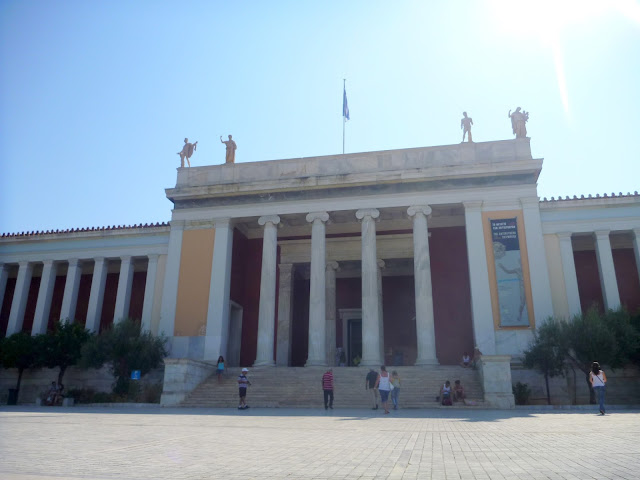The Shipwreck of Antikythera at the National Archaeological Museum in Athens.
Sponge fishermen found the shipwreck in 1900 off the northeast coast of the island of Antikythera. The investigation of the shipwreck inaugurated underwater archaeology. In 1976 the research continued by the Archaeological Service with the help of Jacques-Yves Cousteau and his oceanographic vessel Calypso.
The Antikythera wreck is dated ca 75-50 BC, when commercial shipping and maritime transport of works of art from the eastern Mediterranean to Late Republican Rome had intensified. The island of Delos seems to be the most probable port of embarkation, as the island enjoyed the status of a duty-free port for transit trade between 166 and 69 BC, despite the fact that the chief production centres for most of the items retrieved were northern Syria and Alexandria. The cargo was undoubtedly destined for the Roman market, most probably Rome, where the members of the upper class embellished their villas with Greek pieces of art in order to show off their wealth and social status.
The major part of the vessel and an unknown amount of the cargo still remain in the depth of 50 - 52m, or even deeper.
A large number of antiquities, bronze and marble sculptures, ceramic utensils, bronze and glass vases, gold jewellery, bronze couches, coins, parts of the hull, as well as human remains were recovered. Among the valuable cargo was the Mechanism, the first known calculating and astronomical instrument.
Sculptures:
The Antikythera Youth, 340 - 330 BC, bronze
The young nude male is standing in a frontal pose, holding the right arm up, outstretched to the right. The head is also turned to the right, but the youth does not focus his gaze on the object held in the right hand. There are various interpretations as to who the youth represents, ranging from the Trojan hero Paris, holding the Apple of Discord in the extended right hand and in the left the bow with which he killed Achilles, to the Argive hero Perseus, displaying in the right hand the head of Medusa, grasping her by the hair, and in the other hand the sickle with which he beheaded her.
The Antikythera Philosopher, ca 230 BC, bronze
A portrait of an elderly, bearded man whose individual features are realistically depicted.
The hands, the feet and two fragments of clothing were also found - he held a staff in the left hand, while the right arm, bent at the elbow, was extended in a gesture characteristic of orators.
Boy, beginning of the 1st c. BC, Parian marble
The parts of this sculpture which are clear and bright are those that remained well buried in the sediment of the sea-bed; the others have been deeply eroded by stone-eating mechanisms and marine incrustations.
Hermes, early 1st c. BC, Parian marble (bronze original dates to 350 - 360 BC)
The right side of the head, together with the nose, the face and a large segment of the hair which were buried in the sediment of the sea-bed are preserved in exceptionally good condition.
Ceramics:
As part of its cargo, the ship transported a quantity of fine tableware, mostly plates of various sizes and cups. The main characteristic of these is the bright orange slip and the interior stamped decoration consisting of concentric notched homocentric circles (the so-called rouletting).
This load of pottery was most probably destined to cover the needs of the Roman aristocratic class which had an inclination towards eastern luxury.
The most numerous group of vases (around 47) discovered were the lagynoi, one of the most popular vase of the Hellenic period. Most are unglazed, and some are covered with white slip. They were used for storing and transporting wine. They were part of the ship's cargo.
Jewellery:
Pair of earrings with an Eros pendant, gold, 2-1 c. BC
Glassware:
Exceptionally rare and beautiful glass vessels were retrieved: twenty vases were found intact or partly preserved. There is no doubt that the glass vases were not part of the ship's equipment, but rather its cargo: they were luxury wares, which, like the other works of art the ship was transporting, were probably destined for the markets of Rome.
Glass lobed bowl, 100 - 50 BC
This is the largest of the glass vessels found. On its body sixteen leaves with central vein alternate with sixteen projecting lobes. On the rounded bottom, an eight-petalled rosette.
Glass bowl, 100 - 50 BC
Two multi-leaved olive branches emerge from the top of the bowl and extend over the whole surface to the back of the bowl where they meet, nearly touching each other. On the rounded bottom is an eight-petalled rosette.
Glass bowl, early 1st c BC
Glass mosaic bowl, 75 - 50 BC
Glass mosaic bowl, 75 - 50 BC.


































































